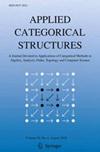德霍诺伊-拉丰阶复数在范畴中的泛化:特殊辫状群的应用
IF 0.5
4区 数学
Q3 MATHEMATICS
引用次数: 0
摘要
通过使用德霍诺伊和拉丰定义的阶复数,可以高效地计算加西德单项式的同调,也就是加西德群的同调。我们构建了这个复数的分类广义,并给出了一些有助于缩短计算时间的计算技巧。然后,我们利用这一构造完成了萨尔维蒂、卡列加罗和马林关于特殊复辫群同源性的研究成果。最值得注意的是,我们通过与之相关的加西德范畴研究了博尔夏特辫状群 \(B(G_{31})\)。本文章由计算机程序翻译,如有差异,请以英文原文为准。
Generalization of the Dehornoy–Lafont Order Complex to Categories: Application to Exceptional Braid Groups
The homology of a Garside monoid, thus of a Garside group, can be computed efficiently through the use of the order complex defined by Dehornoy and Lafont. We construct a categorical generalization of this complex and we give some computational techniques which are useful for reducing computing time. We then use this construction to complete results of Salvetti, Callegaro and Marin regarding the homology of exceptional complex braid groups. We most notably study the case of the Borchardt braid group \(B(G_{31})\) through its associated Garside category.
求助全文
通过发布文献求助,成功后即可免费获取论文全文。
去求助
来源期刊
CiteScore
1.30
自引率
16.70%
发文量
29
审稿时长
>12 weeks
期刊介绍:
Applied Categorical Structures focuses on applications of results, techniques and ideas from category theory to mathematics, physics and computer science. These include the study of topological and algebraic categories, representation theory, algebraic geometry, homological and homotopical algebra, derived and triangulated categories, categorification of (geometric) invariants, categorical investigations in mathematical physics, higher category theory and applications, categorical investigations in functional analysis, in continuous order theory and in theoretical computer science. In addition, the journal also follows the development of emerging fields in which the application of categorical methods proves to be relevant.
Applied Categorical Structures publishes both carefully refereed research papers and survey papers. It promotes communication and increases the dissemination of new results and ideas among mathematicians and computer scientists who use categorical methods in their research.

 求助内容:
求助内容: 应助结果提醒方式:
应助结果提醒方式:


